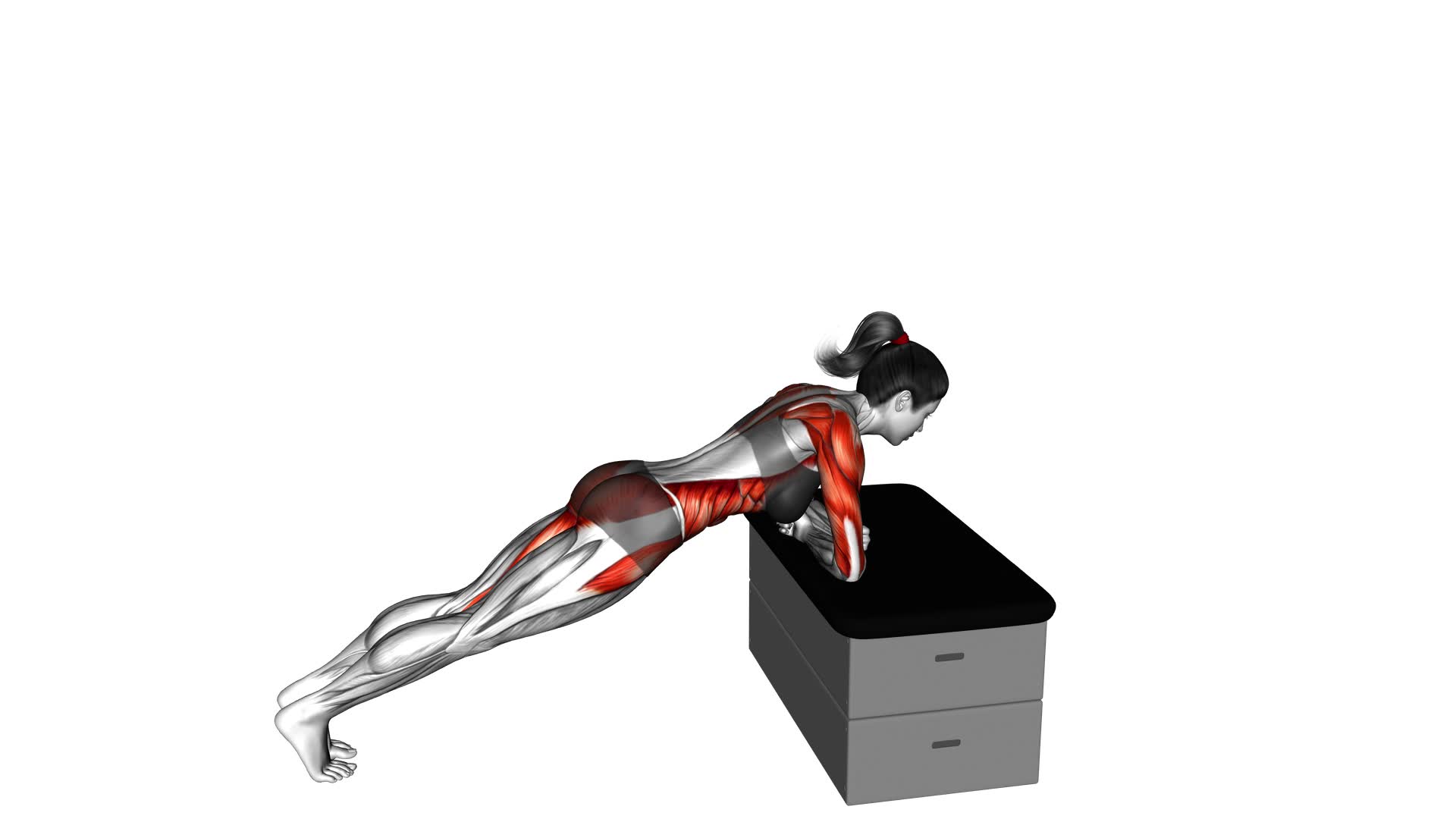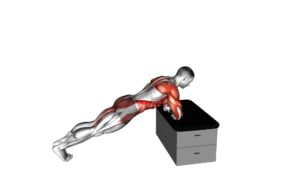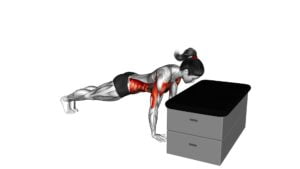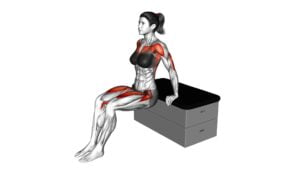Side Plank Rotation a Padded Stool Supported (Female) – Video Exercise Guide & Tips

Get ready to strengthen your core and improve your stability with the side plank rotation.
Watch This Exercise Video
In this video exercise guide, we'll show you how to properly set up a padded stool support for maximum comfort.
You'll learn the correct form and technique to perform this challenging exercise, as well as variations and modifications for all fitness levels.
Avoid common mistakes and maximize your results with these helpful tips.
Let's get started!
Key Takeaways
- The side plank rotation strengthens core muscles, particularly the obliques.
- It improves balance, stability, and posture, while also preventing injuries.
- The exercise aids in performance in other physical activities and tones the oblique muscles.
- There are variations and modifications available for all fitness levels, including side plank hip dips, knee tucks, and leg lifts.
Benefits of the Side Plank Rotation
One benefit of the side plank rotation is that it strengthens your core muscles, particularly your obliques. By engaging your obliques, which are the muscles on the sides of your abdomen, you can improve your balance and stability.
This exercise requires you to support your body weight on one forearm and the side of your feet, while lifting your hips off the ground and rotating your torso. As you rotate, your obliques are working hard to maintain stability and control. This not only helps to tone and strengthen these muscles, but it also improves your overall balance.
Strong obliques play a crucial role in maintaining a stable and aligned spine, which is essential for proper posture and preventing injuries. Additionally, having strong core muscles can enhance your performance in other physical activities, such as running, swimming, or weightlifting.
How to Set Up the Padded Stool Support
To set up the padded stool support for the side plank rotation exercise, you'll need to follow these steps.
- Place the padded stool on a flat and stable surface. Make sure it's positioned perpendicular to your body.
- Position yourself beside the stool, lying on your side with your legs extended. Your bottom elbow should be directly underneath your shoulder, with your forearm resting on the ground.
- Now, place your top hand on the stool for support. Ensure that your body is in a straight line from head to toe.
- To maintain proper positioning, engage your core muscles and lift your hips off the ground, forming a straight side plank position. Your body weight should be evenly distributed between your forearm and the stool.
- Hold this position for the desired amount of time or as instructed by your fitness instructor. Remember to breathe deeply and engage your abdominal muscles throughout the exercise.
Setting up the padded stool support correctly will help you perform the side plank rotation exercise with proper form and effectiveness.
Proper Form and Technique for the Side Plank Rotation
To perform the side plank rotation exercise with proper form and technique, you need to maintain a strong and stable side plank position while rotating your body. Here are some key points to keep in mind:
- Start by lying on your side with your forearm on the ground and your body in a straight line.
- Lift your hips off the ground, creating a straight line from your head to your heels.
- Engage your core muscles to stabilize your body and prevent any sagging or sinking.
- Slowly rotate your torso, bringing your top arm underneath your body and reaching towards the ceiling.
By incorporating these side plank exercise variations and progressions, you can challenge your core muscles and add variety to your workout routine. Some variations to try include:
- Side Plank Hip Dips: Instead of rotating your torso, lower and lift your hips in a controlled manner.
- Side Plank Knee Tucks: From a side plank position, bring your top knee towards your chest and then extend it back out.
- Side Plank with Leg Lift: Lift your top leg while maintaining the side plank position, engaging your glutes and outer thigh muscles.
Remember to listen to your body and start with the basic side plank before progressing to more challenging variations. Proper form and technique are essential for maximizing the benefits of this exercise and reducing the risk of injury.
Variations and Modifications for All Fitness Levels
Explore different variations and modifications of the side plank rotation exercise to accommodate all fitness levels. Whether you're a beginner or an advanced athlete, there are options to suit your needs and abilities.
For beginners, you can start with a modified side plank rotation by bending your bottom knee and placing it on the ground for added stability. This will help you build strength in your core and shoulders before progressing to the full exercise.
If you're looking for a challenge, try the advanced variation of the side plank rotation. Instead of supporting your body with a padded stool, use a stability ball to elevate your feet. This will increase the difficulty by adding an unstable surface, forcing your muscles to work harder to maintain balance.
For those with limited mobility or wrist pain, you can modify the exercise by performing a side plank rotation on your forearm instead of your hand. This will reduce the strain on your wrists while still targeting your core and oblique muscles.
Remember to listen to your body and choose the variation or modification that feels right for you. By incorporating these variations and modifications, you can tailor the side plank rotation exercise to your fitness level and continue to challenge yourself as you progress.
Common Mistakes to Avoid During the Side Plank Rotation
To perform the side plank rotation correctly and avoid common mistakes, it's crucial to focus on proper hip alignment and engaging your core muscles.
Make sure your hips are stacked on top of each other, not sagging or lifting too high.
Engage your core by actively pulling your belly button towards your spine throughout the exercise.
Proper Hip Alignment
To properly align your hips during the side plank rotation, you should frequently check that they're in the correct position. Proper hip alignment is crucial for stability and ensuring that you're engaging the correct muscles during the exercise. Here are some tips to help you maintain proper hip alignment:
- Keep your hips stacked vertically, with the top hip directly above the bottom hip.
- Avoid letting your top hip drop forward or backward.
- Engage your core muscles to stabilize your pelvis and maintain a neutral spine.
- Make sure your shoulders are stacked directly above your supporting elbow or hand.
Improving hip alignment can be achieved through exercises like clamshells, hip bridges, lateral band walks, and quadruped hip extensions. These exercises target the muscles around the hips, helping to improve stability and alignment.
Engaging Core Muscles
Ensure that you're properly engaging your core muscles throughout the side plank rotation to maximize the effectiveness of the exercise and avoid common mistakes.
Engaging your core muscles is crucial for any core strengthening exercises, especially for beginners. When your core muscles are properly engaged, you create a solid foundation that allows you to maintain proper form and stability during the side plank rotation.
This not only helps to prevent injuries but also ensures that you're targeting the right muscles and getting the most out of the exercise. Remember to keep your abdominals tight and your hips lifted throughout the movement.
Tips for Getting the Most Out of Your Side Plank Rotation Workout
To maximize the effectiveness of your Side Plank Rotation workout, it's important that you engage your core muscles throughout the entire exercise. This won't only help you maximize your results but also prevent injuries.
Here are some tips to help you get the most out of your workout:
- Maintain proper form: Make sure your body is in a straight line from head to toe. Keep your hips lifted and your shoulders stacked on top of each other. This will ensure that you're targeting the right muscles and getting the most out of each rotation.
- Control your movements: Slow and controlled movements are key to getting the most out of your side plank rotation. Avoid swinging your legs or rushing through the exercise. Focus on engaging your core and rotating from your torso.
- Breathe properly: Don't forget to breathe throughout the exercise. Inhale deeply as you prepare for the rotation and exhale as you rotate your body. This will help you maintain stability and control.
- Gradually increase difficulty: As you become more comfortable with the exercise, you can increase the difficulty by lifting your top leg or adding a resistance band. This will challenge your core muscles even more and help you achieve better results.
Frequently Asked Questions
Can the Side Plank Rotation Be Done Without Using a Padded Stool for Support?
Yes, you can modify the side plank rotation exercise to be equipment-free.
Instead of using a padded stool for support, you can perform the exercise on the floor.
Start by lying on your side with your legs extended and one forearm supporting your upper body.
Then, lift your hips off the ground and rotate your torso towards the ceiling.
This alternative modification allows you to work your core muscles effectively without the need for any equipment.
How Long Should I Hold the Side Plank Rotation Position?
To properly perform the side plank rotation, focus on maintaining good form. Engage your core, keep your body in a straight line, and rotate your torso while balancing on your forearm and feet.
As for the duration, aim to hold the position for 15-30 seconds on each side, gradually increasing the time as you get stronger.
Can the Side Plank Rotation Help Improve Core Strength?
The side plank rotation is a great exercise to improve your core strength. By incorporating different variations of the side plank rotation, you can challenge your muscles and enhance your overall stability.
This exercise targets your obliques, abs, and back muscles, helping to strengthen and tone them. Not only does the side plank rotation work your core, but it also improves your balance and coordination.
Is It Necessary to Warm up Before Performing the Side Plank Rotation?
To ensure you get the most out of your workout and reduce the risk of injury, warming up before performing the side plank rotation is highly recommended.
A proper warm-up helps increase blood flow to your muscles, improves flexibility, and prepares your body for the exercise.
If you're short on time or looking for alternatives, there are other exercises like planks or Russian twists that can also target your core effectively.
Are There Any Precautions or Contraindications for People With Certain Medical Conditions or Injuries When Performing the Side Plank Rotation?
When performing the side plank rotation, it's important to be aware of any precautions or contraindications due to injuries or medical conditions. Certain conditions like shoulder or wrist injuries may require modifications or alternative exercises.
Always consult with a healthcare professional before attempting this exercise if you have any concerns. It's better to be safe and find a variation that suits your needs rather than risking further injury.
Conclusion
In conclusion, the side plank rotation with a padded stool support is a highly effective exercise that targets your core muscles and improves stability. By following the proper form and technique, you can maximize the benefits of this workout.
Remember to start with the appropriate variations and modifications for your fitness level and avoid common mistakes. Get the most out of your side plank rotation by incorporating these tips into your routine.

Author
Years ago, the spark of my life’s passion ignited in my mind the moment I stepped into the local gym for the first time. The inaugural bead of perspiration, the initial endeavor, the very first surge of endorphins, and a sense of pride that washed over me post-workout marked the beginning of my deep-seated interest in strength sports, fitness, and sports nutrition. This very curiosity blossomed rapidly into a profound fascination, propelling me to earn a Master’s degree in Physical Education from the Academy of Physical Education in Krakow, followed by a Sports Manager diploma from the Jagiellonian University. My journey of growth led me to gain more specialized qualifications, such as being a certified personal trainer with a focus on sports dietetics, a lifeguard, and an instructor for wellness and corrective gymnastics. Theoretical knowledge paired seamlessly with practical experience, reinforcing my belief that the transformation of individuals under my guidance was also a reflection of my personal growth. This belief holds true even today. Each day, I strive to push the boundaries and explore new realms. These realms gently elevate me to greater heights. The unique combination of passion for my field and the continuous quest for growth fuels my drive to break new ground.







